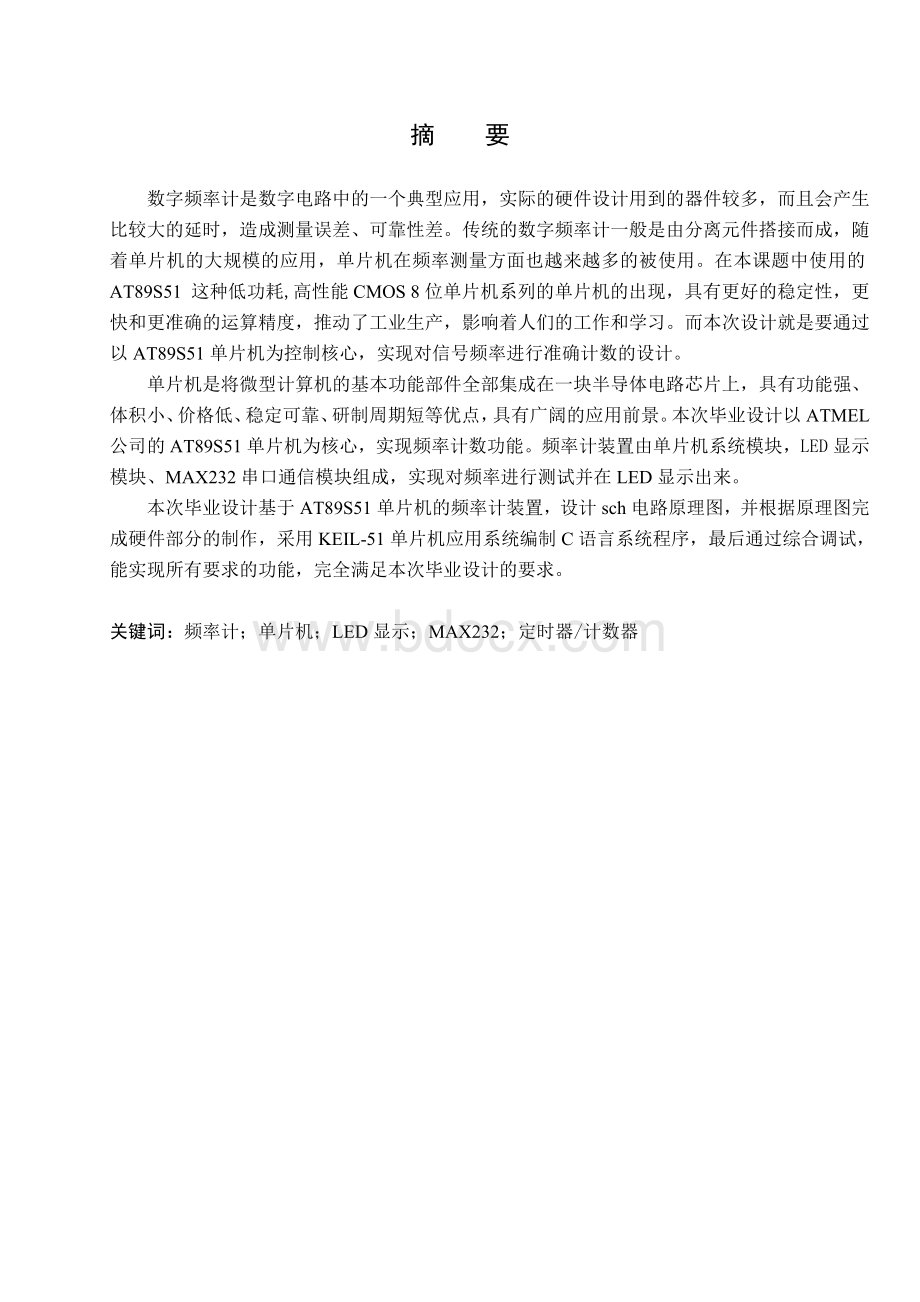毕业设计:基于51单片机频率计的设计文档格式.doc
《毕业设计:基于51单片机频率计的设计文档格式.doc》由会员分享,可在线阅读,更多相关《毕业设计:基于51单片机频率计的设计文档格式.doc(41页珍藏版)》请在冰豆网上搜索。

传统的数字频率计一般是由分离元件搭接而成,随着单片机的大规模的应用,单片机在频率测量方面也越来越多的被使用。
在本课题中使用的AT89S51这种低功耗,高性能CMOS8位单片机系列的单片机的出现,具有更好的稳定性,更快和更准确的运算精度,推动了工业生产,影响着人们的工作和学习。
而本次设计就是要通过以AT89S51单片机为控制核心,实现对信号频率进行准确计数的设计。
单片机是将微型计算机的基本功能部件全部集成在一块半导体电路芯片上,具有功能强、体积小、价格低、稳定可靠、研制周期短等优点,具有广阔的应用前景。
本次毕业设计以ATMEL公司的AT89S51单片机为核心,实现频率计数功能。
频率计装置由单片机系统模块,LED显示模块、MAX232串口通信模块组成,实现对频率进行测试并在LED显示出来。
本次毕业设计基于AT89S51单片机的频率计装置,设计sch电路原理图,并根据原理图完成硬件部分的制作,采用KEIL-51单片机应用系统编制C语言系统程序,最后通过综合调试,能实现所有要求的功能,完全满足本次毕业设计的要求。
关键词:
频率计;
单片机;
LED显示;
MAX232;
定时器/计数器
桂林电子科技大学毕业设计(论文)报告用纸第4页共4页
Abstract
Thedigitalfrequencymeterisinadigitalcircuitmodelapplication,theactualhardwaredesignusescomponentmore,moreovercanhavethequitebigtimedelay,createsthemeasuringerror,thereliabilityisbad.Thetraditionaldigitalfrequencymetergenerallyisbecomesbyseparativeelementjoining,alongwiththemonolithicintegratedcircuitlarge-scaleapplication,themonolithicintegratedcircuitmoreandmorearealsomanyinthefrequencymeasurementaspectisused.AT89S51thiskindoflowpowerlossuseswhichinthistopic,highperformanceCMOS8monolithicintegratedcircuitsseriesmonolithicintegratedcircuitappearance,hasabetterstability,isquickerandthemoreaccurateoperationprecision,impelledtheindustrialproduction,isinterferingwithpeople'
sworkandthestudy.ButthisdesignismustthroughtaketheAT89S51monolithicintegratedcircuitasthecontrolcore,realizesdesignwhichcarriesontothesignallingfrequencyaccuratelycounts.
Themonolithicintegratedcircuitiscompletelyintegratesthemicrocomputerbasicfunctionpartontogetherthesemiconductorelectriccircuitchip,hasthefunctionstrongly,thevolumesmall,thepricelow,stablereliable,thedevelopmentcycleisshortandsoonthemerit,hasthebroadapplicationprospect.ThisgraduationprojecttakeATMELCorporation'
sAT89S51monolithicintegratedcircuitasthecore,therealizationfrequencycountsthefunction.Thefrequencymeterinstallmentbythemonolithicintegratedcircuitsystemmodule,LEDdemonstratedthemodule,theMAX232stringmouthconnectionmodulecomposes,realizescarriesonthetesttothefrequencyanddemonstratesinLED.
ThisgraduationprojectbasedontheAT89S51monolithicintegratedcircuitfrequencymeterinstallment,designstheschelectriccircuitschematicdiagram,andcompletesthehardwarepartialmanufacturesaccordingtotheschematicdiagram,usestheKEIL-51monolithicintegratedcircuitapplicationsystemtoestablishtheClanguagesystemprogram,finallythroughthesynthesisdebugging,canrealizeallrequestsfunction,completelysatisfiesthisgraduationprojecttherequest.
Keywords:
Frequencymeter;
Monolithicintegratedcircuit;
LEDdemonstrated;
MAX232;
Timer/counter
目录
引言…………………………………………………………………………………………1
1基于AT89S51单片机的频率计的设计装置原理图及其设计思路……………………………2
2单片机系统模块原理设计……………………………………………………………………………3
2.1AT89S51芯片介绍………………………………………………………………………………………3
2.2AT89S51芯片管脚介绍…………………………………………………………………………………3
2.3AT89S51复位电路原理…………………………………………………………………………………5
2.4AT89S51的时钟…………………………………………………………………………………………6
2.4.1AT89S51基本时序周期……………………………………………………………………………………7
2.5AT89S51各端口工作原理讲解…………………………………………………………………………7
2.5.1P0口介绍…………………………………………………………………………………………………7
2.5.2P1口介绍…………………………………………………………………………………………………8
2.5.3P2口介绍…………………………………………………………………………………………………9
2.5.4P3口介绍………………………………………………………………………………………………10
2.5.5端口的负载能力和输入/输出操作……………………………………………………………………11
2.5.6串行端口的基本特点……………………………………………………………………………………11
2.5.7串行端口的工作方式……………………………………………………………………………………12
2.5.8串行端口的控制寄存器…………………………………………………………………………………14
2.6定时器/计数器……………………………………………………………………………………………14
2.6.1定时器/计数器结构……………………………………………………………………………………14
2.6.2定时器/计数器控制寄存器……………………………………………………………………………14
2.6.3定时器/计数器工作模式………………………………………………………………………………15
2.6.4定时器/计数器的初始化………………………………………………………………………………16
2.7中断系统………………………………………………………………………………………………17
2.7.1中断系统的结构…………………………………………………………………………………………17
2.7.2中断系统的控制寄存器…………………………………………………………………………………18
2.7.3中断的响应过程…………………………………………………………………………………………19
3硬件设计…………………………………………………………………………………………………20
3.1LED显示模块设计原理…………………………………………………………………………………20
3.1.1LED发光原理……………………………………………………………………………………………20
3.1.2种类和符号………………………………………………………………………………………………20
3.1.3LED的特性………………………………………………………………………………………………21
3.2LED数码管介绍………………………………………………………………………………………21
3.2.1LED数码管原理结构………………………………………………………………………………